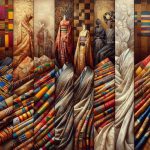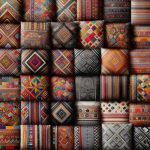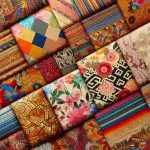When you explore the world of fabrics across different cultures, you'll uncover a tapestry of history and artistry that spans centuries. Imagine the ancient Chinese mastering the delicate art of silk production, or the vibrant patterns woven into West African Kente cloth, each thread telling a story. Indian cotton traditions showcase meticulous hand-spun textiles, while Egyptian linen exemplifies advanced techniques. From Japanese kimono fabrics to European wool, every material reflects a rich heritage and innovative spirit. Curious about how these fabrics have influenced societies and economies through time? There's much more to discover.
Table of Contents
Key Takeaways
- Ancient Chinese silks featured exceptional quality, intricate designs, and refined sericulture techniques.
- Indian cotton traditions involved hand spinning and intricate patterns reflecting regional styles.
- Egyptian linen showcased advanced weaving techniques, symbolizing status and reverence.
- Japanese kimono fabrics employed dye techniques like shibori and yuzen, reflecting cultural artistry.
- West African Kente cloth communicated social status and identity through rich symbolism and meticulous weaving.
Ancient Chinese Silks
Ancient Chinese silks, known for their exquisite quality and intricate designs, have captivated people for thousands of years. You can't help but marvel at the craftsmanship that goes into producing these luxurious fabrics.
The secret lies in the meticulous silk production process, which begins with the cultivation of silkworms. This practice, known as sericulture, involves raising silkworms on a diet of mulberry leaves until they spin their cocoons.
You'll find that the sericulture techniques developed by the Chinese are nothing short of remarkable. Once the silkworms have spun their cocoons, they're carefully harvested. The cocoons are then soaked in hot water to soften the sericin, the protein that binds the silk fibers together.
This step allows the unbroken, continuous silk thread to be unwound, an operation requiring both skill and patience. It's fascinating how these ancient methods have been refined over centuries to produce silk that's both strong and incredibly soft.
As you explore further into the history of Chinese silk production, you'll discover the innovation and dedication that have kept this tradition alive and thriving, making Chinese silk a symbol of elegance and sophistication.
Indian Cotton Traditions
When you explore the rich tapestry of Indian cotton traditions, you'll uncover a legacy of craftsmanship and innovation that spans millennia. Indian artisans have long been celebrated for their ability to create hand spun textiles, transforming simple cotton fibers into masterpieces of fabric. This tradition, deeply rooted in history, showcases the remarkable skills passed down through generations.
The process begins with the labor-intensive task of hand spinning, a technique that imbues each thread with a unique character. This meticulous approach sets the stage for creating textiles that aren't only durable but also incredibly soft.
The real magic, however, lies in the intricate patterns that adorn these fabrics. From the complex geometric designs of Gujarat to the elaborate floral motifs of Bengal, each region in India boasts its own distinct style, reflecting local culture and aesthetics.
Egyptian Linen Legacy
Throughout history, the legacy of Egyptian linen has stood as a proof to the civilization's advanced textile craftsmanship and innovation. As you explore this rich heritage, you'll uncover how ancient Egyptians mastered the art of linen weaving through innovative techniques that set them apart. They skillfully transformed flax fibers into fine, durable fabric, achieving a level of quality that remains unmatched even today.
One remarkable aspect is their use of sophisticated looms and meticulous spinning methods. These ancient artisans didn't just produce linen for everyday use; they created garments that symbolized status and reverence, such as the linen wrappings found on mummies. The precision in their work reflects an unparalleled dedication to perfection.
Fast forward to contemporary times, and you'll see that Egyptian linen continues to influence modern applications. Designers today still hold Egyptian linen in high esteem for its breathability, softness, and durability. Whether used in haute couture or home textiles, the fabric's timeless elegance and practicality make it a preferred choice.
Japanese Kimono Fabrics
Japanese kimono fabrics embody a rich tapestry of cultural heritage, artistry, and meticulous craftsmanship. When you explore kimono textiles, you're diving into centuries of tradition where artisans pour their hearts into every detail. These fabrics often feature intricate geometric patterns, each symbolizing different meanings and stories. The precision of these patterns showcases the artisan's skill and dedication.
To fully appreciate these fabrics, consider the following aspects:
- Dye Techniques: Traditional methods like shibori (tie-dye) and yuzen (hand-painting) are meticulously employed to achieve vibrant and lasting colors.
- Materials: Silk remains the most revered material, though cotton and synthetic fibers are also used, each chosen for specific occasions and seasons.
- Patterns and Motifs: Beyond geometric patterns, you'll find florals, animals, and seasonal motifs that reflect Japanese aesthetics and philosophy.
- Wearability: Kimono fabrics are designed not just for beauty but also for comfort, allowing ease of movement while maintaining elegance.
Understanding these elements gives you a deeper appreciation of the kimono's role in Japanese culture. It's not just a garment but a wearable piece of art that communicates history, status, and identity.
West African Kente Cloth
When you explore West African Kente cloth, you'll uncover its rich symbolism and meanings embedded in each intricate pattern.
Understanding the unique weaving techniques will give you insight into the skill and tradition behind every piece.
Symbolism and Meanings
West African Kente cloth, with its vibrant patterns and colors, carries deep cultural symbolism and meanings. Each hue and design element is intentionally chosen, embedding the fabric with layers of significance.
Understanding Kente demands appreciation of its color symbolism and textile traditions. For instance, black represents maturation and intensified spiritual energy, while gold signifies wealth and royalty. These colors aren't merely decorative but integral to the cultural interpretations embedded within each piece.
The fabric's significance extends beyond its aesthetic appeal, serving as a powerful communicator of social status, history, and identity. When you wear or observe Kente, you're engaging with a rich tapestry of stories and values.
Key symbolic colors in Kente include:
Black: Maturation, spiritual strength
Gold: Royalty, wealth, high status
Green: Renewal, growth, harvest
Red: Political and spiritual struggles
The beauty of Kente lies not only in its visual splendor but also in its ability to convey profound messages about the people and societies from which it originates. By mastering the meanings behind Kente, you reveal a deeper understanding of West African culture and its intricate fabric significance.
Weaving Techniques
Mastering the intricate weaving techniques of Kente cloth reveals the exceptional skill and artistry of the weavers. You begin by understanding the loom innovations that have evolved over centuries. Traditional horizontal looms, used by Ashanti and Ewe weavers, require precise control and coordination. Each strip of Kente cloth, known as 'Ntoma,' is woven with meticulous care, reflecting the weaver's expertise.
Incorporate textile preservation into your routine to ensure the longevity of these vibrant fabrics. Proper storage, away from direct sunlight and moisture, is essential. Regularly inspect the cloth for signs of wear and address any issues promptly to prevent further damage.
| Technique | Description |
|---|---|
| Warping | Aligning threads on the loom |
| Weft Insertion | Interlacing horizontal threads |
| Beating Up | Compacting the weft yarn |
| Pattern Weaving | Creating intricate designs |
| Finishing Touches | Ensuring durability and quality |
Each technique demands precision. Warping aligns the threads on the loom, setting the foundation. Weft insertion interlaces horizontal threads, while beating up compacts them. Pattern weaving showcases the weaver's skill in creating intricate designs, and finishing touches guarantee the cloth's durability.
Cultural Significance
Understanding the intricate weaving techniques of Kente cloth isn't just about craftsmanship; it's also about appreciating its profound cultural significance in West African communities. Each piece of Kente cloth tells a story, woven with traditional methods passed down through generations. You're not just looking at a fabric; you're witnessing a symbol of identity, history, and social values.
Color symbolism plays an important role in Kente cloth. Every hue has a specific meaning:
- Gold: Royalty, wealth, and spiritual purity
- Green: Growth, renewal, and the essence of life
- Blue: Peacefulness, harmony, and love
- Red: Political and spiritual moods, bloodshed, and sacrifice
When you observe Kente cloth, you see cultural preservation come to life. The meticulous weaving techniques ensure that the traditions of the past are kept alive. Yet, don't think Kente hasn't evolved. Contemporary adaptations have made this fabric a beloved choice in modern fashion, blending old-world significance with new-world style.
European Wool and Weaving
How did European wool and weaving become such a cornerstone of the continent's textile history? It all began with the rise of sheep farming, which took off in medieval Europe. The lush pastures of countries like England and Spain provided ideal conditions for raising high-quality sheep.
As a result, wool production flourished, setting the stage for a thriving textile industry. You might wonder why wool became so essential. The answer lies in its versatility and durability, making it perfect for medieval fashion. Nobles and commoners alike favored woolen garments for their warmth and resilience.
The wool trade quickly became a significant economic driver, with towns and cities emerging as centers of weaving and textile production. The process of weaving wool into fabric was both an art and a skill. You'd find entire communities dedicated to the craft, passing down techniques through generations.
Looms, spinning wheels, and other tools evolved, enhancing the efficiency and quality of woven textiles. This intricate network of sheep farming and weaving not only shaped Europe's economy but also influenced its cultural and social structures. Today's European wool industry owes much to these medieval roots, showcasing a legacy of craftsmanship and ingenuity.
Native American Textiles
While Europe was perfecting its wool weaving, Native American communities were developing their own diverse textile traditions using materials like cotton, yucca, and wool from alpacas and llamas. You'd be amazed by the ingenuity and craftsmanship that went into their textiles. Native American weavers employed natural dyes from plants, minerals, and insects to produce vibrant, lasting colors. These dyes were essential in creating the intricate patterns that are both aesthetically stunning and culturally significant.
Consider the following key elements of Native American textiles:
- Materials: Cotton, yucca, alpaca, and llama wool were skillfully utilized.
- Organic Dyes: Derived from natural sources, these dyes provided a broad palette of colors.
- Intricate Patterns: Designs often held symbolic meanings, reflecting the weavers' heritage and beliefs.
- Techniques: Methods like twining, weaving, and embroidery showcased their advanced skills.
You can see how each piece of textile wasn't just a fabric but a story woven into existence.
Frequently Asked Questions
How Has Modern Technology Influenced Traditional Fabric-Making Techniques?
You've seen modern technology revolutionize traditional fabric-making techniques. Innovation and automation streamline processes, enhancing both sustainability and craftsmanship. Mastering this blend of old and new guarantees you're at the forefront of textile excellence.
Which Fabrics Are Considered Most Eco-Friendly Today?
You won't believe how sustainable textiles have revolutionized eco-fashion! Organic cotton, linen production, and hemp fabrics are the champions of eco-friendly materials today. They're practically magic for the environment and your wardrobe.
What Are the Global Economic Impacts of the Textile Industry?
You should know the global economic impacts of the textile industry are significant. Labor exploitation and environmental damage are rampant. However, prioritizing supply chain transparency and fair trade practices can help mitigate these negative effects.
How Do Synthetic Fabrics Compare to Natural Fabrics in Durability?
Have you ever wondered how synthetic fabrics stack up against natural ones when it comes to durability? While synthetics often boast greater wear resistance and longevity, their environmental impact is higher, challenging their sustainability compared to natural fabrics.
What Role Do Fabrics Play in Contemporary Fashion Trends?
You'll find that fabrics greatly shape contemporary fashion trends. Sustainable materials and cultural influences drive innovation, promoting eco-friendly choices and diverse styles. Embrace these elements to master the evolving landscape of modern fashion.
- How Does Ring Spun Cotton Affect Garment Fit and Shape Retention? - August 13, 2024
- What Are the Challenges in Producing Ring Spun Cotton? - August 13, 2024
- Is Ring Spun Cotton Suitable for Plus-Size Clothing? - August 13, 2024







